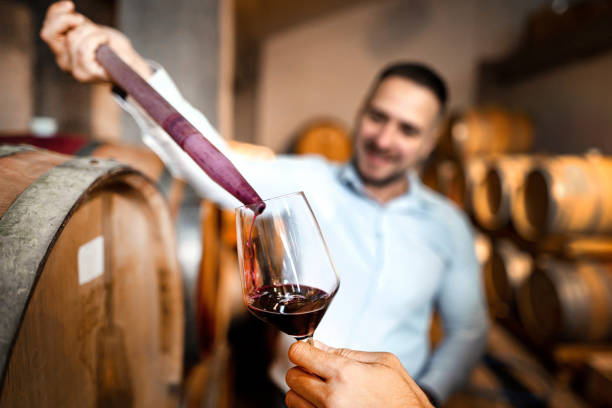When winery visitors enter barrel rooms, they tend to smell the wine and barrels. This causes smiles, surprises, and positive comments. The emotional response to aromas is linked to why people are attracted to wine and other food products. It is not clear how emotions are measured (Meiselman, 2021) or what their relationship is to traditional wine quality attributes like chemical composition and sensory assessment.
It can be difficult for consumers to determine what they enjoy about a wine. Color, taste, and mouthfeel will combine with contextual factors like environmental, sociocultural, and biological factors to create a holistic representation of the experience. Over the past 80 years, there have been many changes in how to measure sensory stimulation. Specific methodologies were developed for consumers and trained panelists. Consumers are usually asked simple questions, such as rating wine based on liking. This can be done with binary scales (like/dislike) or numerical scales (7 or 9 points). Experts or trained panelists in laboratories use quantitative and qualitative methods to gain detailed insights into wine sensory attributes. (OIV 2015). The University of California-Davis 20-point wine scoresheet, for example, is an example of descriptive analysis that breaks down wine qualities into visual, smell, taste, mouthfeel, and finish attributes and assigns quantitative ratings to them. (Jackson 2009, p. 235). To produce reliable results with descriptive analysis methods, panelists must be extensively trained and tested on a regular basis (Meilgaard et al., 2007), which is a logistical and technological challenge.
There is a significant gap between consumer and professional methods for measuring sensory attributes. Consumer methods rely on liking and hedonic rating, which prevents the understanding of the sensory characteristics behind them. Expert techniques, on the other hand, focus more on descriptive attributes while ignoring or minimizing the subjective nature of sensory judgments. Experts often place more emphasis on descriptive attributes, which consumers do not always notice. Examples include balance, finish, the structure of tannin, varietal character, and tannin structure. To deepen the concept of wine, it is necessary to find a point where both hedonic aspects and descriptive ones are combined. Which methods and parameters are able to provide this integration is a critical question. This review will highlight how emotions can be used to bridge hedonic quality, flavor, and context attributes in wines. They would also create a common ground between consumers and wine experts. In the following sections, we will define physiological processes that underlie emotions and discuss current techniques to measure them. In the second part of the review, we will examine the findings of the literature, which describe the use of emotions to characterize the quality of wine.
The physiology behind the perception of flavor
The complexity of the brain, the senses, and the stimuli in the environment have made it difficult to understand human perception. In the last 30 years, neuroscience and psychology have developed tools and techniques that allow us to read physiological signals coming from the brain or other body parts. Psychophysiology and functional magnetic resonating imaging techniques are beginning to provide access to the human mind and decision-making processes, which define our reactions to situations, such as whether or not we like a particular wine. (Frost, 2015; Parr, 2018; Pazart, 2014; Plassmann, 2008; Small, 2012).
The first part of the process involves activating the senses, which operate using sensory neurons and primary brain sensory areas (visual cortex, olfactory bulb, primary olfactory cortex, insula) that are responsible for detecting colors, aromas, and taste attributes. First, the senses are activated. These areas use sensory neurons to see colors, smells, and taste attributes. The signaling generated by these primary brain areas will then start to flow through secondary and higher-order brain areas that are responsible for emotion, memory, and cognition. (Shepherd 2015; Small et al. 2012). In the first phase of the decision-making cycle, our brains move from the stimulus to conscious perception. At this stage, attributes like valence (pleasantness), arousal(intensity), and saliency(prominence) start to be created. (Grabenhorst & Rolls 2011). The signals from the appraisal stage are combined into a single holistic perception known as flavor. (Deco, et al. 2013; Shepherd 2006). Higher-order brain areas, such as the orbitofrontal cortex, allow humans to combine information from wine molecules, memories of past experiences, and feelings evoked during the primary processing stage. All of these inputs are combined and weighted in order to produce responses, such as whether to continue drinking the wine, buy a bottle, or reject a wine because it has an unpleasant defect. (Kringelbach, 2012; Rolls, 2008; Shepherd 2006). This is called value-based decision-making (Deco et al., 2013; Grabenhorst & Rolls, 2011; Shepherd, 2006), and it is prone to input from other signals than the wine, such as culture, prior experiences, and social environment.
Figure 1.
How the brain processes wine-related stimuli and what types of responses are elicited.
The taster may continue to approach the wine if it has a pleasing response. They will likely grab the glass, take another sip, and use language to describe each of its qualities. If the wine is unpleasant, for example, because of an excessive amount of volatile acidity, the taster may discard the sample and ask for another wine. These reactions both require facial muscles for articulation and arm muscles for approaching the wine or writing a description. The final result of the previously described value-based decision-making process is these observable behaviors. In sensory evaluations, behavioral outcomes are recorded by explicit measures, such as rating scales or the frequency of tasters’ preference for a sample. Other processes occur “behind the scenes” as well, such as changes to the autonomic nerve system (ANS). (Rene A. de Wijk and Boesveldt 2016; Kreibig 2010). When faced with an unpleasant or disgusting stimulus, for example, tasters often frown instinctively (Larsen, 2003; Wolf, 2005). Bodily responses from the autonomic system, such as frowning, sweating, heart rate changes, skin temperature changes, and respiration rates, can be characterized by implicit measures; one of their main features is that these reactions are automatic and, in many cases, unconscious. These bodily signals are also considered to be a fundamental mechanism for representing emotional behavior (Kaneko et al., 2018). They can provide a deeper understanding of how wine consumers perceive it. The primary role that emotions play in wine perception and their relationship to explicit and implied measurements is the basis for the next section. It will describe emotion to help understand its adoption as a wine quality attribute.




